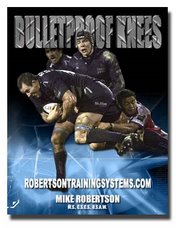Mike,
Love the blog!
Can you talk a little bit more about what you mean by 'cybernetic programming', and give us some examples of how you use that?
Thanks!
Yudi Kerbel, NASM-CPT
First off, thanks for the question Yudi! If anyone else has questions they want me to cover, please leave them in the "Comments" section.The term cybernetic periodization was first coined (as far as I'm aware of) by Mel Siff in his textbook Supertraining. The essence of the concept is that you need to be able to adjust your training on the fly dependent upon how you're feeling. Here's an example:
My MMA fighter Dan came in for his workouts this week looking beat up. Now, this is to be expected - he's training at a new facility with better fighters, AND he's peaking for a fight next weekend. While I still would've liked for him to get a few heavy/explosive lifts in this week, it wasn't really in the cards as I had originally programmed.
If I were a slave to the program as originally written, he would've lifted heavy regardless - but in all honesty, that would've been stupid. I would've beaten him up worse, his lifts would probably have looked terrible, and I'd risk getting him injured. Also, in case I didn't mention it before, Dan is an MMA fighter - I have no desire to be arm-barred or choked out in my own gym!
Instead, we focused on getting a good lift or two in each day and then really geared back his assistance lifts. This gives him extra recovery time and, in the long run, will allow him to be at his best come next weekend.
That's the essence of cybernetic periodization - lift hard/heavy/fast on the days you feel really good. On the days you don't, gear things back so that the next time you hit the gym you're ready to go. It really comes down to listening to your body and doing what it's capable of on any given day.
I hope that helps - good luck!
Stay strong
MR









4 comments:
Thanks so much for the response, Mike. Very interesting!
If I may request, I would definitely like to see more blog content regarding your philosophies on program design, and some of the principles you've discovered after years of trial and error in learning how to design the best strength and conditioning programs. Alwyn Cosgrove refers to them as his 'a-ha!' moments. I would definitely love to hear yours.
Thanks again!
Yudi Kerbel NASM-CPT
How many days a week does your mma guy train with you? Also do you handle his conditioning work or just the strength portion? Thanks.
Gio -
I have an article running this week at T-Nation re: my Ah-Ha Moments.
Shadow -
Dan trains with me 2x/week - I plan all his strength and conditioning work. He does all his skill/technical work on his own.
MR
Good stuff here Mike as always! I am excited to see your A Ha moments!
For this topic, I agree that you can't just beat athletes into a pulp because it says so on paper and some form of cybernetic/autoregulatory method is the way to go.
Question--what biofeedback from the athlete do you use? Just general feelings (feel good, bad), movement quality (gait, range of motion testing), or heart rate, etc? If funds were unlimited, what would you use?
Good luck to your fighter!
Rock on
Mike N
Post a Comment